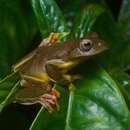pt-BR
nomes no trilho de navegação


Rhacophorus htunwini (Htun Win’s treefrog) was originally described in 2005, as an 11th species of brown treefrogs (Rhacophorus) found in Myanmar.It was named for U. Htun Win, late herpetologist from Myanmar who initially recognized the species as potentially new to science from specimens he collected as part of an expedition in 2002 and 2003 from Rakhine State in western Myanmar near the Bay of Bengal, and from Kachin State in northeastern Myanmar near the Chinese border. However, in 2007 a study synonymized R. htunwini as junior subjective synonym of the red-webbed R. maculates (Bordoloi et al. 2007); Frost (2014) lists R. htunwini as no longer recognized rather it is included in R. bipunctatus Ahl, 1927 along with R. maculates.
The 2005 analysis of Rhacophorus htunwini described it as a mid-sized treefrog (snout-vent length 37.8-50.4 mm; 1.5-2 inches), with smooth dorsal skin and large disc-shaped finger and toe pads living in bamboo shoots near springs or streams, consistently about two meters (6 feet) off the ground (Wilkinson et al. 2005).Recognizing its closest relative as R. bipunctatus, also found in Myanmar, Wilkinson et al. (2005) described characters distinguishing (male) Htun Win’s treefrogs from R. bipuntatus, as well as other Rhacophorus, and species of the closely related Polypedates.These characters included extensive yellow webbing between its toes, a pointed snout, bright green dorsal coloring, yellow coloring on the top of the eye, and two dark black spots on the sides of their bodies fringed at the top with blue dots.(While Polypedates has been established as a separate genus by molecular means, there is still confusion of species placement between these two genera; Wilkinson et al. 2002).
This 2005 paper suggested that R. htunwini inhabited the Indoburman mountain range along the western border of Myanmar and India north through the eastern Himalayas in Northern Myanmar, and hypothesized its presence in the Chin Hills of Western Myanmar (Wilkinson et al. 2005).Suprio Chakma (2007) extended the range of R. htunwini to Bangladesh, in Kaptai National park at about 350 m in elevation.Bangladesh specimens were found on trees 3-8 meters above ground, near a rainwater pool.
The range of R. bipunctatus (as revised by Bordoloi et al. 2007) is listed by Frost (2014) as: “Eastern Himalayan region of northeastern India (Assam, Arunachal Pradesh, Meghalaya, Manipur, Tripura, and Nagaland), adjacent northern Bangladesh, and eastern Xizang [= Tibet] (China) to Yunnan, Hunan, Hainan, and Guangxi, China, and Laos and Vietnam in the Annam Mountains and the Tay-Nguyen Plateau; Cardomom Mountains of southwestern Cambodia; Karin Hills of Myanmar; northern peninsular, western and eastern Thailand and Perak, Malaya.”
The twin-spotted tree frog (Rhacophorus bipunctatus Ahl, 1927) is a species in the moss frog family (Rhacophoridae).It occurs in the eastern Himalayans of India, Bangladesh, southeastern China, Myanmar and possibly south to Malaysia mostly between 1000-2000 meters in altitude.
This species has a complex and confusing taxonomy as a large number of closely related and similar-looking species exist, some in overlapping ranges.Due to the identification problems surrounding this species, the eastern and southern limits of its range require more work to fully determine.Recent work has synonymized R. maculatus, bimaculatus and htunwini into R. bipunctatus and removed R. rhodopus from synonymy as proposed by Inger et al. 1999 (Bordoloi et al. 2007; Frost 2016; Yu et al. 2007); however some taxonomic disagreement still exists.
The dorsal side of Rhacophorus bipunctatus is green to brown in color.Its slightly larger size and coloring distinguish it from the often confused red-brown to yellow R. rhodopus that Bordoloi et al. (2007) separated as a distinct species.Rhacophorus bipunctatus almost always has one or more black spots on its flanks and its feet have orange webbing without black spots.A small frog, adults measure 37–60mm (males smaller than females).It inhabits subtropical or tropical moist montane forests, high-altitude shrubland, intermittent rivers, freshwater marshes, and also can be found in plantations and rural gardens (Ohler et al. 2008; Wikipedia 2016).
Rhacophorus bipunctatus is an arboreal species.Frogs in this genus have extensive webbing between their toes, which allows it to glide from tree to tree.The adults spawn in bubble nests hung on branches over standing water so hatching tadpoles fall into puddle or stream below to develop (Ohler et al. 2008; Wikipedia 2016).
Rhacophorus bipunctatus is generally common, and considered of least concern by the IUCN.It frequents human-impacted environments.In India it is collected for food and medicine (Ohler et al. 2008).